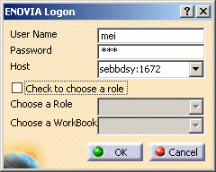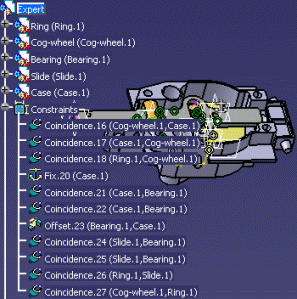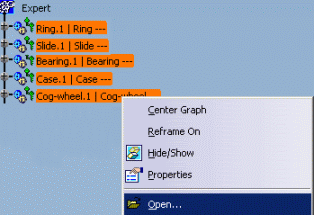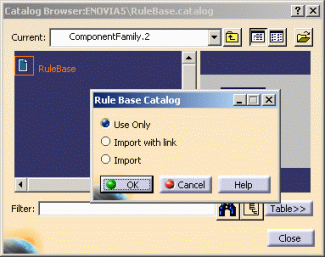- selected ENOVIAV5 in the View > Toolbars menu.
- made the option ENOVIA as Allowed in the Document Environments field (Tools>Options>General>Document.)
![]()
-
Create a Product in ENOVIA V5 VPM (in this scenario the product is named Expert). Note that you can close ENOVIA V5 VPM after creating the Product.
Send the Product to CATIA
-
To send the product to CATIA:
- In CATIA, click the Connect icon (
 )
in the ENOVIA V5 toolbar. The ENOVIA Logon
dialog box is displayed:
)
in the ENOVIA V5 toolbar. The ENOVIA Logon
dialog box is displayed:
- Enter your user name and your password.
- Select your role in the Role scrolling list and the workbook and click OK.

- Click the ENOVIA Search icon
(
 ).
The VPM Search dialog box is displayed.
).
The VPM Search dialog box is displayed. - In the Objects scrolling list, select the Product option.
- Enter the owner's ID.
- Click OK when done. The Product ID is displayed in the Result window.
- Double-click the product. The VPM Navigator view is displayed.
- Right-click the root product (Expert) and select Open.... The Open Modes dialog box is displayed. Leave the default settings and click OK. The CATIA view is displayed.
- In CATIA, click the Connect icon (
Add Components to the Product
-
Click the root product, select Insert>Existing Component... and select the following documents:
-
Optional: Access the assembly design workbench to add constraints to the saw.

-
Save the product in ENOVIA. To do so, click the Save in ENOVIA icon (
 ).
The Save in ENOVIA dialog box is displayed. Click OK.
).
The Save in ENOVIA dialog box is displayed. Click OK.
Create a Part Containing Expert Checks
This Part is the one that will be used to create the catalog.
-
Create an empty Part or open the RuleBase_Catalog.CATPart file.
-
If you opened RuleBase_Catalog.CATPart, go to step 12. If not, from the Start>Knowledgeware menu, access the Knowledge Expert workbench.
-
Click the Expert Check icon (
 ).
Enter the name of the check (Hole_Check) in the Check Editor and click
OK.
).
Enter the name of the check (Hole_Check) in the Check Editor and click
OK. -
Enter the following check, and click OK when done.
H:Hole(H.Diameter == 11.0 mm) AND (H.Activity == TRUE) -
Click the Expert Check icon (
 ).
Enter the name of the check (Fillet_Check) in the Check Editor and click
OK.
).
Enter the name of the check (Fillet_Check) in the Check Editor and click
OK. -
Enter the following check, and click OK when done.
H:ConstantEdgeFilletH.Radius >= 2mm -
Save the Part in ENOVIA. To do so, click the Save data in ENOVIA V5 icon (
 ).
The Save in ENOVIA dialog box is displayed.
).
The Save in ENOVIA dialog box is displayed. -
Click the
 button
and select the line referring to the RuleBase_Catalog.CATPart and click
Modify. Click the root product (Expert) in the VPM
Navigator view and click OK. The Part is saved in ENOVIA.
button
and select the line referring to the RuleBase_Catalog.CATPart and click
Modify. Click the root product (Expert) in the VPM
Navigator view and click OK. The Part is saved in ENOVIA.
Create the Catalog Linked to the Rule Base and Store it in ENOVIA V5 VPM
-
From the Start>Infrastructure menu, access the Catalog Editor workbench.
-
In the Catalog Editor, select Chapter1, then click the Add Family icon (
 ).
).
The Component Family Definition dialog box is displayed. Click OK. The new family is added to the tree. -
Double-click the family then click the Add Component icon (
 ).
The Description Definition dialog box is displayed.
).
The Description Definition dialog box is displayed. -
Click Select external feature then select the Rule Base contained in RuleBase_Catalog.CATPart. A catalog containing your RuleBase is created. Click OK when done.
-
Save the catalog in ENOVIA. To do so, click the Save data in ENOVIA V5 icon (
 ).
The Save in ENOVIA dialog box is displayed.
).
The Save in ENOVIA dialog box is displayed. -
Click the Catalog name and rename the catalog: RuleBase.catalog.
-
Select the line referring to this catalog and click Modify. Click the root product (Expert) in the VPM Navigator view and click OK.
-
Close all windows in CATIA.
Import the RuleBase From the Catalog
|
 |
-
Click the Catalog Browser icon (
 )
in the Catalog tool bar.
)
in the Catalog tool bar.
|
 |
-
Select the RuleBase.catalog (RuleBase) in the Search Result window and click Open.
-
Double-click ComponentFamily, then RuleBase in the Catalog Browser until the RuleBase Catalog window is displayed.

-
Check the Import with Link option and click OK.
| A new technological package is created that contains the RuleBase and the checks. |
-
Right-click the Rulebase and select RuleBase object>Manual Complete Solve to solve the RuleBase. The checks are applied.
-
Right-click the Rulebase and select RuleBase object>Report... to display the report. Click OK in the Select directory window: The report is displayed.
![]()